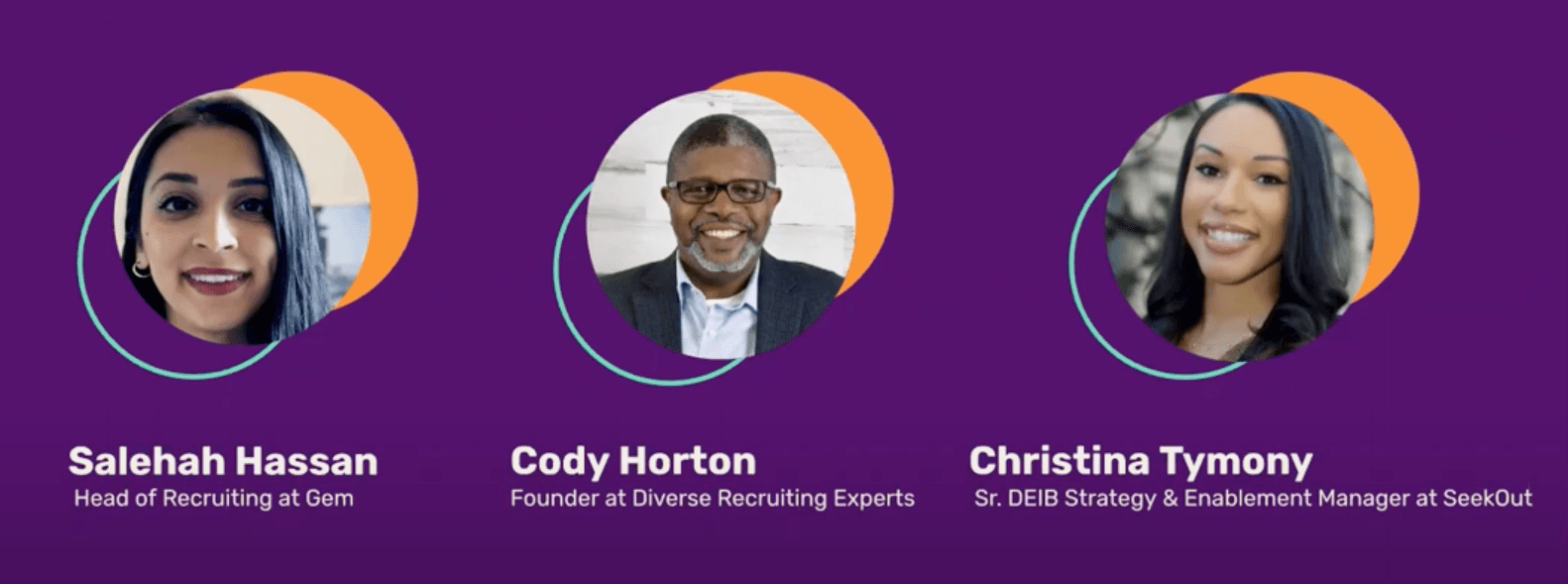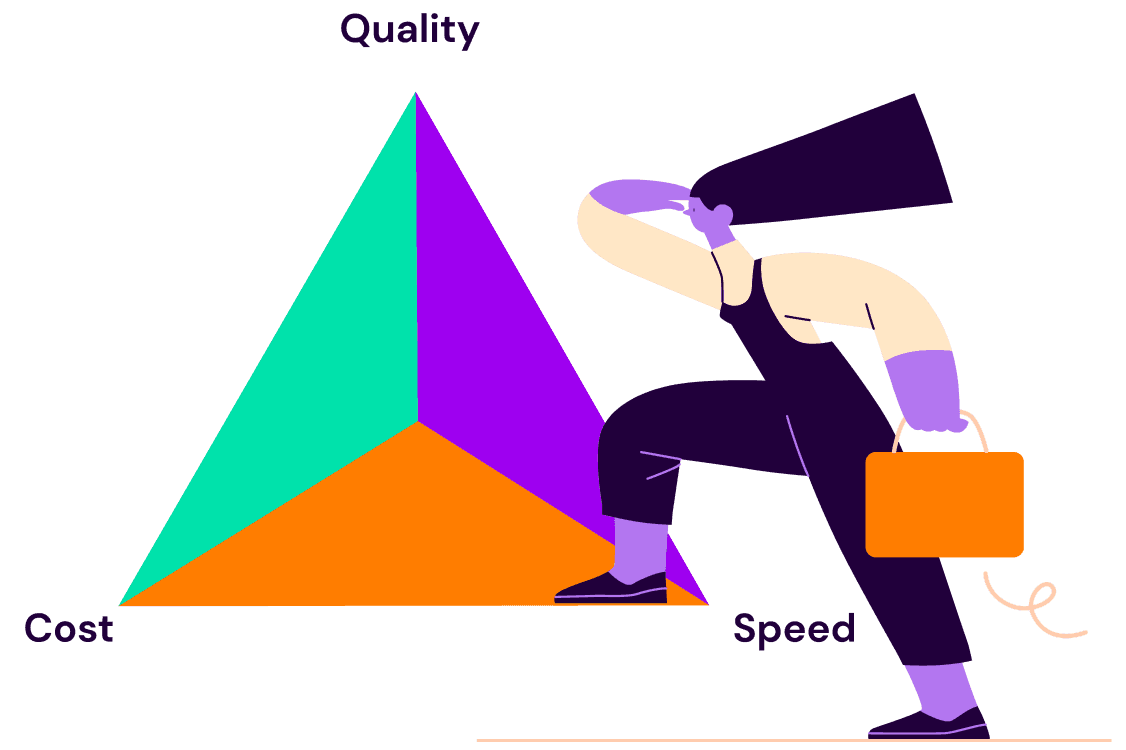
Back to blogs
As layoffs and hiring freezes continue to impact the tech space, talent teams that want to emerge stronger are investing in diversity, equity, inclusion, and belonging (DEIB) initiatives.
Research from McKinsey shows that the relationship between diversity on executive teams and the likelihood of financial outperformance has strengthened over time.
When it comes to profitability, the ROI of DEIB investment is clear. In a recent Talent Board webinar, SeekOut’s Sr. DEIB Strategist & Enablement Manager Christina Tymony joined a panel of talent leaders for a moderated discussion led by Talent Board President Kevin Grossman.

Speakers:
Kevin Grossman (moderator), President & Board Member, Talent Board HR
Christina Tymony, Sr. DEIB Strategist & Enablement Manager, SeekOut
Cody Horton, Founder, Diverse Recruiting Experts (acquired by HireBetter)
Salehah Hassan, Head of Recruiting, Gem

Prefer to watch the entire conversation? Access the recording here.
What is the "state of the state" when it comes to DEIB work?
Salehah Hassan: I read an interesting article on why DEIB efforts fail that focused on how companies approach layoffs. Layoffs have a negative impact on DEIB when organizations cut positions instead of evaluating individual workers. Right now, URGs (underrepresented groups) and diversity programs are highly affected by layoffs. For 2023, we need to build on strategic programs to support DEIB while hiring is slow.
Cody Horton: I’m seeing fatigue. People aren’t seeing the results that they want to see and there’s a lot of competition for resources due to companies wanting to cut costs. There’s a lot of reprioritization and still a lot of work to be done. Talent leaders have a lot of questions around how to most effectively use resources to support this work moving forward.
Kevin Grossman: A big question is not only how to use our resources, but how do we not lose them? Unfortunately, DEIB work can be tabled or cut during times of uncertainty and that’s a mistake.
Christina Tymony: One of my passions around the work is around economic empowerment and making sure underrepresented groups have equal access to opportunities. There’s a lot of concern around how this year will impact DEIB efforts. DEIB teams have been hit hard by the layoffs. I’m focusing on how to embed this work throughout organizations so, it’s no longer a nice-to-have. When times are tough, we should know that this work is entrenched into the priorities and accountabilities that are driving the actions of our teams.
4 ways to create a more equitable workforce
1. Create an inclusive interview process
Salehah Hassan: I recommend two tactical strategies for supporting an inclusive interview process.
Source a strong diverse top of funnel. I advise hiring managers to keep a few specific skills for the role but broaden their requirements in other areas (e.g., location and company size.). Providing talent mapping with data on talent pools will help get hiring manager buy-in.
Prep candidates before interviews. This is an important step and candidates have different preferences for how to receive information (e.g., email, phone, and documents). Make sure candidates are aligned with the interview process expectations and use more than one channel to communicate these details.
Christina Tymony: It’s important for teams to remain gender neutral with language and be mindful of people’s pronouns—we shouldn’t make assumptions around someone’s identity. In our current remote environment, our hiring teams should be mindful of the digital divide and be considerate if a candidate can’t do a video interview due to bandwidth concerns or other issues.
2. Ensure fair and unbiased candidate assessment
Christina Tymony: We can rely on best practices and tools that mitigate bias, but solutions aren’t a one- and-done fix. We must stay vigilant and keep that top of mind. There are two parts to building fair candidate assessment.
Hiring team enablement. Think about who will interact with the candidate and be part of the selection process. Then, make sure those stakeholders are aware of their own biases and can break down the root of these biases.
For example, I worked with a hiring team with a preference for candidates from the big four tech companies. I worked with them to understand why they thought candidates from large tech companies were more qualified. It turned out the hiring team was afraid to make poor hiring decisions, and didn’t feel confident in their ability to interview for certain traits, like working well under pressure. Since we got to the root of the bias, we equipped the team with the tools they needed to evaluate candidates with diverse backgrounds. Adding a reminder to a calendar invite for interviewers to check their bias can help keep this top of mind.
Create a structured interview process to reduce subjectivity from the assessment process. Work with the hiring manager to only identify what is essential for the role. From there, designate a set number of interviews, select specific questions, and make sure every candidate goes through the same process.
3. Train hiring managers and interviewers on fair hiring practices
Cody Horton: Structured interviews are a must. It’s important for interviewers to be able to practice interviewing and BrightHire offers a tool for that. Another critical piece is for hiring managers to focus on must-haves—they should evaluate candidates against the role requirements instead of interviewing one candidate against another candidate.
Interviewers must understand that communication style differs across candidates. Encourage interviewers to ask a question, stick with the candidate, and probe via follow-up questions if the answer is communicated differently than they expected it.
You want the ownership for the interview to shift to the interviewer. They should feel accountable for getting the most information out of the candidate. The interviewer must take accountability as part of the interview team.
Salehah Hassan: To partner effectively with hiring managers, recruiters should spend time getting to know the hiring manager and the organization before jumping into an intake meeting. This helps build a foundation of trust with the hiring manager and team. The focus should be on building a partnership versus offering a service.
4. Remove biased and exclusionary language from job descriptions
Christina Tymony: I’ll start with “the why” behind making job descriptions more inclusive. Studies show that people in underrepresented groups won’t apply for roles if they don’t meet 100% of the job requirements. This means there are a group of folks who will self-select out of the process before you get a chance to speak with them.
One of the biggest players in creating inclusive job descriptions is Textio. The tool identifies gendered language, jargon, and language that's geared toward specific communities, like rockstar or ninja. It’s also important to remove language that points to a fixed mindset versus allowing room for growth. If you don’t have access to a paid tool like Textio, take a look at your peers to see how they write job descriptions, and Gender Decoder is a free tool.
We have to create a space where people read our job descriptions and feel welcome. At SeekOut, we include a blurb in our descriptions that encourages candidates who don’t meet every qualification to apply. We want to open the gate and have more people come to us.
Cody Horton: I agree with Christina, the job description should be as inclusive and inviting as possible. TalVista, Hemmingway and Microsoft Word are other tools that pick up on writing tone, reading level, and other biased language.
Final takeaways for creating an equitable workforce this year
Salehah Hassan: Do more with less. Focus on the three things you want to do well, instead of the ten things.
Cody Horton: Focus on the psychological safety at work. I’m reading The Four Stages of Psychological Safety by Dr. Timothy Clark and it addresses inclusion.
Christina Tymony: Focus on changing behaviors and outcomes. Move away from reporting actions without outcomes. If we worked on hiring manager enablement, are we seeing candidate feedback scores increase or parity improve?
Want more? Watch the full recording.
Want to learn more about creating an equitable workforce in 2023?
Transform your talent strategy with human-centric, AI-assisted tools from SeekOut. Learn how to improve representation across talent pipelines and address unconscious bias in the recruiting process by scheduling a demo with our team.
See us in action
Learn how SeekOut unifies people data to help organizations reach their talent goals
Request a demo




